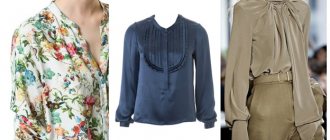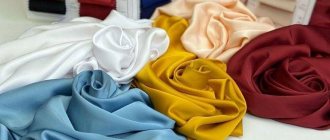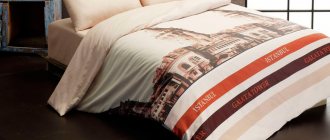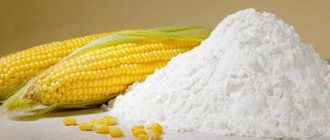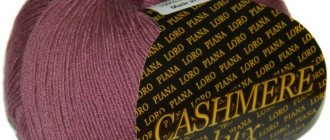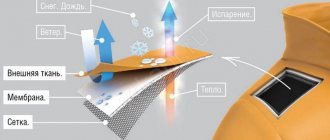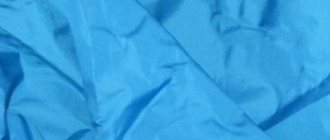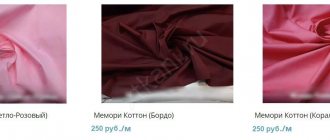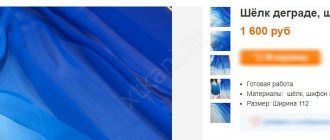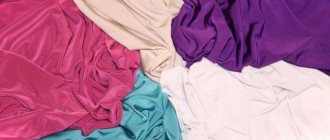Back in the Middle Ages, a small island in the English Channel was famous for the production of natural woolen fabric, from which underwear and work clothes for fishermen were made. This island was called Jersey. The harsh climate made it possible to raise sheep with soft and warm wool.
Jersey came into the world of fashion in 1916 thanks to the famous French designer Coco Chanel. She outraged the public by deciding to sew elite clothes for rich, famous and influential ladies from seemingly unpresentable material. Chanel's innovations shocked the public, but the beauty of her taste invariably convinced her clients of the successful choice of material and style of the clothes offered.
Over time, jersey production technology developed, and cotton, silk and synthetics began to be used to create the fabric.
History of fabric
On the English island of Jersey, blown from all sides by cold, piercing winds, a breed of sheep with warm, soft wool has long been raised. Wool was used to produce fabric from which warm work clothes for fishermen and underwear were made. The fabric was named after the island - jersey.
In the 19th century, clothing manufacturers tried to adapt knitwear to make tracksuits. The idea failed, the suits were not sold out, the factories that produced them went bankrupt and closed.
Jersey fabric gained its popularity at the beginning of the 20th century, thanks to the world famous Coco Chanel. The fashion designer presented a jersey coat in her collection. The reaction of society ladies was negative, a huge scandal broke out, and the show was a failure. Ladies considered it indecent to wear clothes made from lingerie fabric. But Coco Chanel did not give up, and at the next show beautiful dresses made of jersey jersey were released. The sophistication of the taste of the famous designer did their job, the fabric was accepted by the public.
The key to quality and comfortable clothing
It is thanks to its properties that jersey fabric has become so popular. This is a light, silky material that is practically not felt on the body. This characteristic makes it a good choice for creating summer clothes and light dresses.
The fabric has hygroscopic properties. It perfectly absorbs moisture and ensures free air circulation. Therefore, clothes made from jersey jersey are comfortable at any time of the year.
A high level of wear resistance is another advantage of the material. These clothes withstand frequent washing and intensive use. Pills do not appear on the product, and the product itself does not shrink.
Composition and types of fabric
At the beginning of its history, jersey was made from sheep's wool. Nowadays knitwear is made from wool, cotton, silk, synthetic threads, and their combinations.
Depending on the raw materials used, fabrics are divided into main groups:
- natural - made from threads of natural origin (classic wool, cotton, linen, silk);
- artificial - from viscose, bamboo;
- synthetic - from lycra, polyester, elastane.
The combination of different types of threads in one fabric allows you to combine the properties of all components in it, achieving the required qualities and properties.
Eco-friendly jersey fashion
View this post on Instagram
Just imagine how many football players there are all over the world, and each one has an individual uniform for every important competition. The creative association “Kruzhok” has come up with its own way to wisely use such a stock of things. They collected T-shirts from famous football players and altered them.
This idea has grown into a separate creative project in which football kits are being recycled. Upcycle gives new life to an item with the goal of extending its life in a new look. The guys from Kruzhk create shortened versions, sew two parts from different jerseys, and sometimes even come up with a model from scraps and combine them using the patchwork technique. The result is an unusual and eye-catching jersey, with which you need to wear mom-fit jeans in black, beige or blue without prints or other details, so that the jersey remains the main part of the look.
View this post on Instagram
In the summer, you can tuck a football jacket into a black tennis skirt or shorts, and if your height allows, use the jersey as a dress.
Jersey properties, advantages and disadvantages
The properties of a fabric primarily depend on the fibers it contains.
Jersey has many advantages .
- Elasticity, the ability to stretch. The canvas stretches across the width of the fabric, not lengthwise.
- Wrinkle-resistant, easy to care for. The material does not require constant ironing; clothes made from it are easily stored on shelves in the closet; even with this storage method, folds and creases do not form.
- Softness. The fabric is pleasant to the touch, suitable even for sewing clothes for babies who have delicate and sensitive skin.
- Thermal conductivity. Clothing made from jersey wool fibers will prevent you from freezing during the cold season and allows you to regulate heat transfer.
- Hygroscopicity. The fabric absorbs and retains moisture. Synthetic jersey does not have this property; it is not advisable to wear clothes made from it in the heat.
- Breathability. The material breathes and allows air to pass through.
- Eco-friendly, hypoallergenic. This only applies to natural jersey. It does not cause skin irritation and is safe.
- Lightness, weightlessness. The fabric does not restrict movement, its weight is almost not felt when worn.
- Wear resistance. The material can withstand a large number of washes, after long-term use it does not fade, does not become shiny, does not rub, or stretches.
- The fabric lays in soft rounded folds and does not form creases.
The disadvantages include the peculiarities of jersey.
- The fabric hugs your figure. If the silhouette is not perfect, all imperfections will be visible.
- The surface of the jersey may develop pilling over time.
- The material becomes electrified and sticks to the body. This is uncomfortable and unaesthetic. To a greater extent, this disadvantage is inherent in synthetic jersey. To reduce electrification, you can use special aerosol products, they help a lot.
Types of Jersey
Modern classification distinguishes material by its constituent fibers. There are three main types - natural, synthetic and artificial .
The first group includes fabrics containing wool, cotton, linen or silk . It is possible to add a small amount of viscose and other synthetic fibers:
- Elastane is often added to cotton jersey to make the material durable.
- The most expensive type of jersey is silk fabric. The surface of the material is particularly smooth and attractive in appearance.
- Wool jersey is the warmest type of knitwear, providing comfort at any ambient temperature.
The base of synthetic jersey is polyester . To give better properties, elastane, lycra, spandex and other fibers are added to the fabric. All of them serve to improve elasticity; this type of fabric is also called stretch jersey. The main positive characteristic of synthetic material is its wear resistance and durability. From this point of view, knitwear can even compete with nylon.
Artificial fabric is a material based on fibers obtained from wood . Most often, bamboo and viscose fiber obtained from cellulose processing are used for this. These materials are environmentally friendly and do not cause allergic reactions.
Application area
Jersey fabric is versatile. Great for sewing clothes for every day. Depending on the composition of the fibers, the material is used to sew:
- underwear - made of thin jersey (silk, viscose);
- jackets and coats - made of thick jersey (wool);
- evening dresses are attractive in silk jersey;
- casual dresses, office and travel suits, T-shirts, trousers - from all types of jersey;
- children's clothing - mainly made of cotton jersey;
- home clothes, dressing gowns, pajamas;
- pantyhose stockings.
Photo
Jersey fabric photo 3
Jersey knit dresses
Jersey bedding
Jersey fabric photo 1
Jersey knit fabric
Jersey fabric photo 2
Care instructions
The fabric is not fancy, the rules of care are simple.
- Be sure to study the product label, which indicates the composition and basic care instructions. Observe them strictly. Only in this case will the item last a long time.
- Suitable for both hand washing and machine washing in an automatic machine, with water at a temperature of up to 40 degrees, to avoid deformation and loss of shape of the product.
Deformation without restoring its original shape is possible if care recommendations are not followed: when washing a woolen item in hot water, it will certainly shrink.
- The use of neutral powders and fabric softeners is allowed.
- You can spin it in the drum of a washing machine at a low speed.
- It is recommended to rinse in cool water, up to 20 degrees, to maintain color durability and brightness.
- It is better to dry naturally in a horizontal position, away from radiators and heaters. Before drying, straighten the product well.
- Iron through damp cotton cloth. Set the iron to the minimum temperature, if possible, to the steam mode. If available, you can use a household steamer.
- Store products in a well-ventilated area, avoiding exposure to sunlight.
A hot iron will damage the surface of the fabric, leaving shiny spots on it.
Properties of the material, its characteristics
Due to the fact that jersey fabric has a predominantly natural composition, it is characterized by a wide range of advantages:
Regulates heat exchange and allows air to pass through well
Features a soft texture that provides a pleasant tactile sensation
Characterized by ease of care
Keeps its shape perfectly, does not wrinkle when crumpled
It is wear resistant. Even after prolonged wear it looks fresh and neat
Universal in use. Suitable for sewing any items
Easily stretches, but retains its shape without compromising quality
Hypoallergenic. Does not cause redness or irritation
Comfortable to wear and does not restrict movement
Follows the shape of the body
Maintains bright colors
Features an affordable price
Are there any downsides to jersey fabric? There are certain disadvantages, but they are fully compensated by a wide range of advantages. The disadvantages include the following:
Jersey products, how to choose and how to wear
- The original jersey is easy to recognize: when the fabric is stretched wide, it will easily stretch, and its edge will curl up.
- When purchasing jersey outfits, pay attention to the features of your figure. A straight, tight-fitting dress will suit those with a fragile, slender figure. Overweight women should choose models with elegant folds that hide imperfections and emphasize femininity.
- Choose the composition of the product according to the season. Wool jersey is popular in autumn and winter, and cotton jersey is popular in spring and summer. Don't buy synthetic jersey for the summer; in hot weather it's completely uncomfortable.
- Jersey clothing is simple and not overloaded with details; it can be combined with costume jewelry, jewelry and accessories. Depending on the situation, a silk scarf or woolen stole will complement the look well.
Description
Jersey fabric is a dense industrial knitwear. It turns out to be a single-row loop weaving. The rows of braids are clearly visible on the front side, and on the back there is a monochromatic, transverse pattern. The structure of the jersey can be seen in the photo.
The material is soft and pleasant to the touch. Breathable and moisture-wicking, allowing you to feel comfortable in hot and cold weather. Jersey, even from coarse wool, is light and smooth. Reliably protects from cold and wind without irritating the skin.
Knitwear is produced in plain colors, with a printed pattern and jacquard. New technologies make it possible to do a shiny coating, apply a print, and treat with special compounds to obtain the required properties, for example, water and dust repellent, antibacterial.
The fabric looks attractive and is appreciated by fashion designers. Each new collection includes jersey clothing. The material drapes beautifully in the product with soft, voluminous folds, and the silhouettes are slender and sophisticated.
Clothes made from this material can withstand heavy use without losing their original qualities.
Customer Reviews
Customers often leave positive reviews of jersey products. The durability of the products and the versatility of the fabric are most often noted. Owners of jersey clothes are satisfied, the items wear well, fit well, people emphasize that they do not need to be ironed, they are warm, light, and comfortable in all respects. The few who did not follow the fabric care standards were disappointed ; their clothes became stretched and deformed, becoming unsuitable for wear.
Jersey has won customer recognition due to its high quality and unique properties. This practical and durable fabric is happily used by designers all over the world for sewing clothes; every home is sure to have items made from it.
Production technology
Pleated Jersey
Jersey is a knitted fabric, that is, a knitted fabric. The structure of the fabric is an interlocking loop, a connection of rows and posts, rather than perpendicular warp and weft threads (as in plain or twill weave, for example). Properties characteristic of knitwear:
- elasticity and flexibility;
- extensibility;
- softness.
The material is made using special textile machines that automatically knit a single-row fabric. Currently, not only wool is used to make jersey, but also:
- cotton is a natural plant thread, hypoallergenic, economical and affordable;
- silk is a thread made from silkworm cocoons, elegant, expensive and very durable;
- viscose and bamboo - artificial fibers from wood cellulose and bamboo stems;
- polyester is a synthetic polyester thread that is very wear-resistant.
The product label should contain information about fabric care.
The characteristics of the material depend on the exact composition of the fabric. The manufacturer is required to indicate it on the product label along with care instructions. Synthetic fibers reduce the degree of fabric creasing and reduce the price of the product, so you should not be afraid of them. Natural threads provide effective heat retention, hygroscopicity and air exchange.
To distinguish jersey from other knitted fabrics, you should stretch the raw edge of the fabric - it will be tightly wrapped in a small roll.
Video: what is jersey
An interesting video about where jersey fabric came from, why women love it and why everyone who sews clothes appreciates it.
See similar articles
- Lycra is an elastic fabric that fits tightly to the figure.
- Crepe satin is a wrinkle-resistant fabric with a silky sheen.
- Modal - lightweight cellulose fabric for linen and clothing
- Linen is a natural and eco-friendly fabric
- Eco-leather is an analogue of genuine leather on a fabric basis.
- Staple - lightweight breathable fabric for summer clothing
If you liked the article, share it with your friends!
Secrets of the cut
In order to create a beautiful outfit from jersey fabric, you should contact a specialist, because this material is difficult to cut. The master will quickly deal with it, while independent work using homemade scissors can ruin everything.
Pre-washing jerseys made from natural fibers will help prevent shrinkage. After this manipulation, you can begin cutting. To sew clothes from this material, special needles for knitwear are used.
The history of the creation of thick knitwear
This fabric got its name from the island of the same name in Normandy, where the fabric was woven for several centuries before it became known outside Britain.
Initially, wool from a breed of sheep living in this area was used to make it. This wool produced a thin, durable fabric that was used exclusively for making underwear for the low-income working classes.
For a long time, jersey remained a clothing material for the poor, but the rich islanders did not pay attention to this simple and unsightly material. especially revered among fishermen, who often faced strong piercing winds and rain.
This material was introduced to high society by the world famous Coco Chanel, who began using it to make dresses, skirts, suits, and outerwear items. At the fashion show, Chanel dressed the models in outfits made from linen for the working class. Fragile girls looked great in these clothes, which caused an unprecedented stir in social circles.
Standards and norms for manufacturing
The Gosstandart requirements for the manufacture of knitted fabrics, which include jersey, are set out in GOST 28554-90.
It states, in particular, that the technical description of the fabric must necessarily contain information about the type of knitting equipment, the name of the weave, the number of loop columns and loop rows, elongation under a load of 6 N, abrasion resistance group and all permissible deviations. For example, the permissible deviations in surface density are minus 5%.
Privacy Policy
General provisions
Some objects posted on the site are the intellectual property of StoreLand. The use of such objects is established by the current legislation of the Russian Federation.
The StoreLand website contains links that allow you to go to other sites. StoreLand is not responsible for the information published on these sites and provides links to them only to provide convenience to visitors to its site.
Personal information and security
StoreLand guarantees that any information received from you will never, under any circumstances, be provided to third parties, except in cases provided for by the current legislation of the Russian Federation.
In certain circumstances, StoreLand may ask you to register and provide personal information. The information provided is used solely for official purposes, as well as to provide access to special information.
Personal information can be changed, updated or deleted at any time under Account > Profile.
To provide you with certain types of information, StoreLand, with your express consent, may send informational messages to the email address specified during registration. At any time you can change the subject of such mailings or refuse it.
Like many websites, StoreLand uses cookie technology, which may be used to promote our product and measure the effectiveness of advertising. In addition, with the help of this technology, StoreLand is configured to work with you personally. In particular, without this technology it is impossible to work with authorization in the control panel.
The information on this website is for informational purposes only and is subject to any changes without any prior notice.
